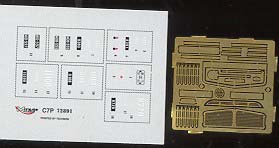Mirage 1/72 Ciagnik Artyleryjski C7P (Polish C7P Heavy Artillery Tractor) Kit No. 72891
MSRP: $19.98
Sqaudron Price: $17.97 |  | History: The C7P tractor was manufactured in Poland by Panstwowe Zaklady Inzynieryjne (State Engineering Works) from 1935. Its design used components of the Vickers 6T tank, built under license in Poland in a modified form as the 7TP (which had the same chassis as the the Soviet T-26 series). The first tractors were introduced into service with the 1st Heavy Artillery Regiment (HARgt) at Gora Kalwaria which converted in 1935 to the 220mm Mark 1932 mortars purchased from Czechoslovakia. Eventually, five C7P tractors were required for each mortar: one for the barrel carrier, one for the carraige, one for the undercarraige, and two for equipment and ammunition trailers. According to the establishment, each two-gun battery should have 11 tractors. Outside of the 1st HARgt, the C7P tractors were planned to be used as recovery vehicles in light tank companies, two vehicles per company, and mobile armour areas would include 14 vehicles each. C7P tractors were also used in railway engineer units, each railway bridge company scheduled to have 1-3 tractors, either on tanks or rails. According to incomplete information, the following numbers of C7P tractors were in service prior to the oubreak of WWII: seven at the Armoured Weapons Training Centre at Modlin, five in the cnd Armoured Battalion at Zurawica, four in the 3rd Armoured Battalion in Warsaw, two in the 4th Armoured Battalion at Brzesc nad Bugiem, and three in the 5th Armoured Battalion in Cracow. Immediately prior to the outbreak of war four surplus vehicles of the type, from the Maind Depot of Armoured Weapons Material, were allocated to the 12th Armoured Battalion at Luck for the 21st Light Tank Battalion equipped with French R-35 tanks then being formed. Moreover, after the war broke out, single tractors were still at the Armoured Weapons Training Centre and No. 1 Armoured Weapons Replacement Centre. A number of C7P tractors were allocated to 20 mobilised railway bridge companies, and at least one tractor on rails was used by No. 1 Railway Bridge Engineer Replacement Centre. The fates of the C7P tractors during the 1939 campaign are difficult to accertain. More information is available only on the vehicles of the independent 11th , 12th, and 13th HARbt of the 1st HARgt, which had a total of 99 C7P tractors. What's in the box?  This third kit from Mirage also comes in a end-opening box. It contains two cello bags that have seven parts trees divided between them. There is a zip-lock bag that holds a small fret of brass PE parts. These parts provide the frame and screening for the engine air intake and other small details. If PE parts, this tiny, scare you they can easily be left off. The decal sheet provides for the markings of six different schemes. Colors are called out in both Humbrol and Vallejo paints, with Vallejo being prefered. Again, I would have prefered to have been told the colors rather than the numbers used. No crew figures are provided. This third kit from Mirage also comes in a end-opening box. It contains two cello bags that have seven parts trees divided between them. There is a zip-lock bag that holds a small fret of brass PE parts. These parts provide the frame and screening for the engine air intake and other small details. If PE parts, this tiny, scare you they can easily be left off. The decal sheet provides for the markings of six different schemes. Colors are called out in both Humbrol and Vallejo paints, with Vallejo being prefered. Again, I would have prefered to have been told the colors rather than the numbers used. No crew figures are provided.  The number of fine detail parts in this kit are almost mind-boggling! The tracks are the vinyl rubber-band type. The number of fine detail parts in this kit are almost mind-boggling! The tracks are the vinyl rubber-band type. Color schemes are shown in either Polish Khaki, a mix of sand and olive green, or the wave pattern shown on the box art. Again, the instruction sheet is very well done and provides no less than 29 assembly steps. Conclusion Make no mistake, of the three kits received for review, this one is the MOST detailed. There must be close to 200 parts in this kit. That is truly a whopping amount for a 1/72nd scale kit. I swear that Mirage shrunk down all the parts they have in their 1/35th scale offerings of the C7P. By the way, they do this kit in three versions, in both scales. There is the straight Polish one, a Soviet one with external fuel tanks on the rear, and a version that is in captured service by Germany. I have this last version in 1/35th scale. I did a review of it in a past issue of Internet Modeler, and it has a crane in the kit that the Germans added to the rear to make it a sort of recovery vehicle of sorts. I assume that the 1/72nd scale kit would have this option too. This kit, most of all, I would never recommend to the beginner. The parts are, in a lot of cases, super-teeny and the shag rug monster (whom us modelers all fear) would just love to eat them. So, be darn careful with this kit. I wear tri-focals and can barely see some of these parts. Definitely not your week-end build project. Like the other two kits, this one is very cleanly molded and flash free. Most of any ejector pin marks are designed to be hidden after assembly. Nice touch Mirage! Thanks to Squadron (MMD) for the review sample | 








|
